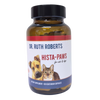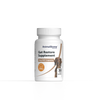A holistic pet wellness plan must address not only what goes into your pet’s body, but also the environment they live in. Unlike humans, dogs and cats spend most of their time close to the floor, where dust and chemical residues gather. Studies now show that long-term exposure to everyday household toxins is linked to rising cases of disease in pets. Including cancer and endocrine disorders. Understanding these hidden threats is your first step toward reducing your pet’s overall chemical load and safeguarding their health for the long run.
Everyday Toxins That Build Up in Pets
Our pets live much closer to the ground than we do, rolling on rugs, licking their paws, and breathing in the same air we share. Over time, tiny amounts of everyday household chemicals can build up in their bodies and quietly affect their health.
Some common culprits include:
1. Cleaning Products
Many common cleaners contain harsh chemicals like bleach, ammonia, and phenols. Even after drying, residues can linger on floors and furniture, where pets absorb them through their paws or ingest them while grooming.
Why It’s Harmful: These ingredients can irritate the skin and lungs and may stress the liver and kidneys over time. Some can even act as endocrine disruptors, which interfere with hormone balance, a concern linked to feline hyperthyroidism.
Safer Alternatives: Use pet-safe, fragrance-free cleaners or DIY versions made with vinegar, baking soda, and lemon juice. Always rinse surfaces well after cleaning.
2. Air Fresheners and Scented Plugins
Scented sprays, candles, and plug-ins release volatile organic compounds (VOCs) and synthetic fragrances into the air.
Why It’s Harmful: These airborne chemicals can irritate your pet’s respiratory system and, with long-term exposure, may affect hormone balance. Some VOCs have been associated with increased risks of hormone-related and bladder issues, including canine bladder cancer.
Safer Alternatives: Choose unscented or naturally scented options made with pet-safe essential oils (like lavender or chamomile), but avoid tea tree and eucalyptus oils, which can be toxic to pets.
3. Laundry Detergents and Dryer Sheets
Your pet’s bedding, toys, and even your clothes can carry residues from detergents and dryer sheets containing dyes, benzene, and formaldehyde.
Why It’s Harmful: These chemicals can cause skin irritation and allergic reactions, and some are suspected endocrine disruptors.
Safer Alternatives: Use fragrance-free, non-toxic detergents and skip dryer sheets altogether. Wool dryer balls soften fabrics naturally.
4. Pesticides and Lawn Treatments
Weed killers, ant traps, and rodent poisons are among the most toxic household hazards. Pets can track lawn chemicals indoors or lick them off their paws during grooming.
Why It’s Harmful: These substances can cause vomiting, seizures, or worse, and long-term exposure places added strain on your pet’s detox organs.
Safer Alternatives: Choose pet-safe pest control, such as diatomaceous earth for insects or vinegar-based weed sprays. Always wipe your pet’s paws after outdoor play.
5. Plastic Food and Water Bowls
Plastic bowls can leach chemicals like BPA and phthalates, both endocrine disruptors, into your pet’s food and water.
Why It’s Harmful: These compounds may interfere with hormone regulation, potentially contributing to metabolic, reproductive, or behavioral changes over time.
Safer Alternatives: Opt for stainless steel, glass, or ceramic bowls, they’re safer, more durable, and easier to clean.
6. Hidden Indoor Sources
Beyond products, everyday materials like carpets, non-stick cookware, and even tap water can contribute to your pet’s chemical exposure. Flame-retardant-treated furniture and flooring have been tied to feline hyperthyroidism, while certain cleaning fumes and plastics have links to canine bladder cancer.
Small exposures may not seem like much, but together they add up. The good news is that by choosing safer cleaning products, filtering your pet’s water, and keeping paws wiped after outdoor walks, you can dramatically lower their chemical burden and protect their long-term health.
Actionable Steps for a Toxin-Free Life
Reducing this environmental burden is a tangible step in your holistic pet wellness plan:
-
Upgrade Air & Water: Use a high-quality carbon filter for all drinking water (for both you and your pets) and utilize HEPA air filters to capture dust-bound contaminants like flame retardants.
-
Cleaning Swaps: Replace conventional, harsh cleaners with simple, natural alternatives like vinegar, baking soda, and plant-based, scent-free cleaners to eliminate residue on floors.
-
Pet Gear Audit: Wash pet beds and blankets frequently. When replacing furniture or pet beds, look for products certified as free of chemical flame retardants.
Conclusion: Supporting the Liver's Essential Work
Protecting your pet from environmental contaminants is a lifelong task. By choosing non-toxic alternatives, you dramatically reduce your pet's bioaccumulation of harmful substances. A robust holistic pet wellness plan acknowledges that, since eliminating all toxins is impossible, internal support is vital.
Help your pet's body process the unavoidable environmental challenges. Explore the pet detox supplements, formulated to optimize the liver's detoxification pathways and boost overall systemic resilience.
If you’re serious about reducing your pet’s toxin load and supporting long-term wellness, explore our guide:
👉 How to Flush Toxins Out of My Dog and Cat Naturally at Home
















